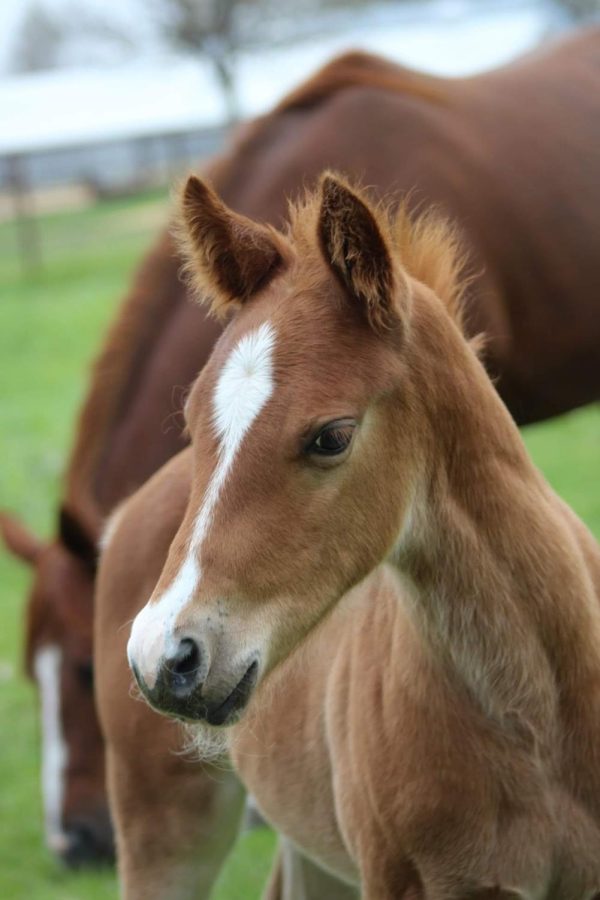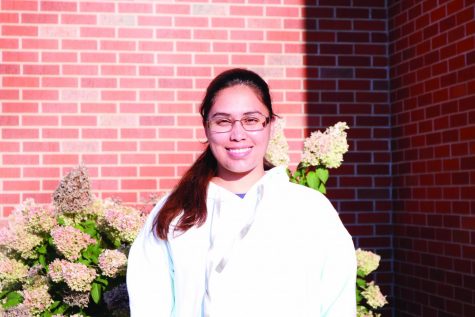Foaling season begins soon at SDSU
Pepper is one of the many foals at SDSU.
March 8, 2022
The horse unit at South Dakota State University has been raising Quarter horses for over 65 years, and this spring marks the beginning of another foaling season at the facility.
Carmen Paulson, the equine lecturer within the Department of Animal Science, teaches all of the horse classes offered at SDSU for the equine Ssudies minor and is the Horse Club adviser here on campus. Paulson said by taking the horse production class, students learn about feeding, breeding and management principles.
Even though the horse production class is for animal science majors and minors, students must take “three prerequisite courses for [the horse production class] AS476,” Paulson said. “These are AS319, Livestock Feeds and Feeding, AS333, Livestock Reproduction, and AS332 ,Livestock Breeding & Genetics.”
By attending the horse production class via lab and lecture, students gain a better understanding of selection and breeding of quality stock, along with the breeding and foaling of mares. They also learn to assess vital signs and recognize health problems in horses used for production, Paulson said.
Jen Eide, the Equine Teaching Facility manager for the Department of Animal Sciences, works with Paulson and gets to see the day-to-day functions of the facility and help coordinate labs.
According to Eide, the horses are just about a month away from when they will begin giving birth.
“We will start foaling around March 23, and are expecting broodmares to foal through the first week of May,” Eide said. “Students enrolled in Horse Production have the opportunity to observe the foaling process by signing up to cover overnight shifts.”
The students who work at the facility help cover the weekends and workday. They also have 10 students employed at the facility to take care of and comfort the pregnant horses.
“A broodmare carries her foal for 11 months, or approximately 340 days,” Eide said.
Amber McElmury, a senior majoring in animal science specializing in industry and a general member of the Horse Club at SDSU, is currently taking the horse production class. She noted common behaviors of mares about to give birth.
“When mares get within a few hours of giving birth, they will become very restless,” McElmury said. “They may sniff around on the ground a lot, lay down and rise frequently and just act like they cannot get comfortable. This is because the foal is repositioning itself to make an appearance in the world.”
Some of the horses like the help provided and others want some privacy; students and faculty watch via camera until there is a need to intervene.
They intervene when the foal needs help getting rolled up on its sternum for better breathing or to remove excess fluid from the nose. They also help to get the broodmare to get up after foaling and disinfect the umbilical cord when it tears, Eide said.
As some intervene to help, others quickly and quietly reset her foaling box with fresh straw so that the foal has a clean and dry environment. Then they wait for the mare and foal to begin the bonding process. The bonding process is when the foal stands up to seek its mother. During this process, the foal will learn its mother’s voice. The foal then searches for the mother’s udder for its first meal, Eide said.
A newborn foal looks unproportional when they are born.
“They have very long legs and a slender body,” McElmury said. “They have colored hair all over their body, and longer hair on their neck and tail.”
The students and faculty respect when the mares want to be alone, which is evident when the mare blocks the view of her foal, butts her rear to the stall door and stares down whoever is present by shaking her head or by stamping her feet. But the student’s duty isn’t complete until the foal has been licked dry by the mare, has eaten multiple feedings by itself and has defecated and urinated without struggling, Eide said.
“The relationship between a mare and her foal is generally a very strong bond,” McElmury said. “The mare is very protective of her new baby and will guard the little guy from other horses. Most mares will allow humans to interact with their baby, but that is only because the mare trusts the human.”
Eide added that mares can be bred again shortly after giving birth.
“If everything has gone well and both mare and foal are healthy, the mare can be back in foal for the next year in 2 weeks. Mares are amazing in their ability to reproduce when they are healthy and well cared for,” Eide said.
The stallions are used after foaling to rebreed the mares for the next year; it’s usually done by April 20 thru June 5, so students in the next year can learn the process as well, Eide said.
The foal is weaned or separated from its dam in the fall semester, as it will be a part of the AS 104, Intro to Horse Management, where it will be handled and halter trained by the students.
The colts (boys) and fillies (girls) are used in the equine minor program.
The younger horses go through different classes, as they will be trained for the next four years to be a teaching animal for other students to learn from. Then they will be reliable to be mounted for riding.
Just like the younger horses, some are placed in laboratories, Little International, children’s field trips, educational petting zoos, judging schools and State FFA judging contests.

























